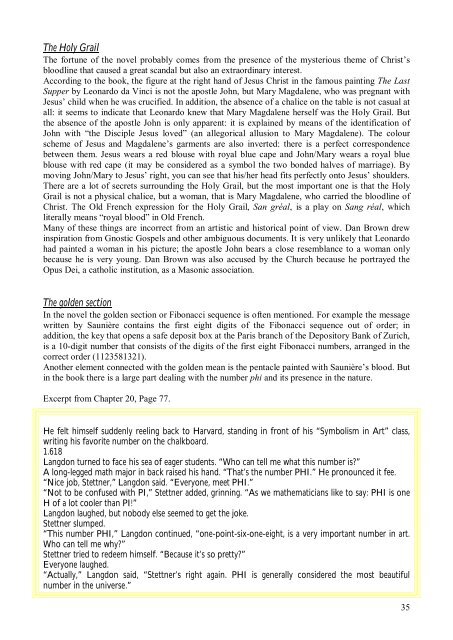Create successful ePaper yourself
Turn your PDF publications into a flip-book with our unique Google optimized e-Paper software.
The Holy Grail<br />
The fortune of the novel probably comes from the presence of the mysterious theme of Christ’s<br />
bloodline that caused a great scandal but also an extraordinary interest.<br />
According to the book, the figure at the right hand of Jesus Christ in the famous painting The <strong>La</strong>st<br />
Supper by Leonardo da Vinci is not the apostle John, but Mary Magdalene, who was pregnant with<br />
Jesus’ child when he was crucified. In addition, the absence of a chalice on the table is not casual at<br />
all: it seems to indicate that Leonardo knew that Mary Magdalene herself was the Holy Grail. But<br />
the absence of the apostle John is only apparent: it is explained by means of the identification of<br />
John with “the Disciple Jesus loved” (an allegorical allusion to Mary Magdalene). The colour<br />
scheme of Jesus and Magdalene’s garments are also inverted: there is a perfect correspondence<br />
between them. Jesus wears a red blouse with royal blue cape and John/Mary wears a royal blue<br />
blouse with red cape (it may be considered as a symbol the two bonded halves of marriage). By<br />
moving John/Mary to Jesus’ right, you can see that his/her head fits perfectly onto Jesus’ shoulders.<br />
There are a lot of secrets surrounding the Holy Grail, but the most important one is that the Holy<br />
Grail is not a physical chalice, but a woman, that is Mary Magdalene, who carried the bloodline of<br />
Christ. The Old French expression for the Holy Grail, San gréal, is a play on Sang réal, which<br />
literally means “royal blood” in Old French.<br />
Many of these things are incorrect from an artistic and historical point of view. Dan Brown drew<br />
inspiration from Gnostic Gospels and other ambiguous documents. It is very unlikely that Leonardo<br />
had painted a woman in his picture; the apostle John bears a close resemblance to a woman only<br />
because he is very young. Dan Brown was also accused by the Church because he portrayed the<br />
Opus Dei, a catholic institution, as a Masonic association.<br />
The golden section<br />
In the novel the golden section or Fibonacci sequence is often mentioned. For example the message<br />
written by Saunière contains the first eight digits of the Fibonacci sequence out of order; in<br />
addition, the key that opens a safe deposit box at the Paris branch of the Depository Bank of Zurich,<br />
is a 10-digit number that consists of the digits of the first eight Fibonacci numbers, arranged in the<br />
correct order (1123581321).<br />
Another element connected with the golden mean is the pentacle painted with Saunière’s blood. But<br />
in the book there is a large part dealing with the number phi and its presence in the nature.<br />
Excerpt from Chapter 20, Page 77.<br />
He felt himself suddenly reeling back to Harvard, standing in front of his “Symbolism in Art” class,<br />
writing his favorite number on the chalkboard.<br />
1.618<br />
<strong>La</strong>ngdon turned to face his sea of eager students. “Who can tell me what this number is?”<br />
A long-legged math major in back raised his hand. “That’s the number PHI.” He pronounced it fee.<br />
“Nice job, Stettner,” <strong>La</strong>ngdon said. “Everyone, meet PHI.”<br />
“Not to be confused with PI,” Stettner added, grinning. “As we mathematicians like to say: PHI is one<br />
H of a lot cooler than PI!”<br />
<strong>La</strong>ngdon laughed, but nobody else seemed to get the joke.<br />
Stettner slumped.<br />
“This number PHI,” <strong>La</strong>ngdon continued, “one-point-six-one-eight, is a very important number in art.<br />
Who can tell me why?”<br />
Stettner tried to redeem himself. “Because it’s so pretty?”<br />
Everyone laughed.<br />
“Actually,” <strong>La</strong>ngdon said, “Stettner’s right again. PHI is generally considered the most beautiful<br />
number in the universe.”<br />
35


